The established media has published a barrage of misinformation and lies about ambergris for decades. Most publications are sensationalized rubbish; stories of people picking up vast fortunes of ambergris valued at unrealistic prices. None of the established media reports on ambergris are qualified or supported with fact. Many refer to ambergris as “whale vomit” even though a quick reference to Wikipedia would tell them otherwise. They report that ambergris is an intestinal slurry to protect the whale from sharp squid beaks but none ever provide any reference to qualify that assertion. None of the fiscal values of ambergris are qualified with an actual confirmed financial transaction between buyer and seller. Instead a figure is plucked out of thin air and applied to an amount of alleged ambergris. There is no doubt that there is an concerted effort made by the worlds established media to misrepresent ambergris. And the reason for that is advertising revenue.
Stuff
Recently in New Zealand (NZ) the established media has plunged to an all time low. The catalyst for this plunge can be found at a NZ media organization called “Stuff”. A reporter for Stuff, Hamish McNeilly ran a series of articles during February 2021. As follows:
On Monday 1 February (NZ time) Hamish McNeilly of Stuff ran a story on Stuff’s webpage titled, “Thousands of dollars of ambergris, dog poo or something else?”. That question had already been answered. The story is about a woman in Dunedin (NZ) who did not pick up ambergris at a local beach. The non-ambergris was taken the the Otago Museum on Thursday 28 January and the curator- Kane Fleury confirmed it was not ambergris. However 1 working day later McNeilly thought it appropriate that this non-event be published.
AmbergrisBeware has made ample reference to to notorious NZ ambergris fraud and scammer – Duncan Harold Payne.
On the following Thursday 4 February Duncan Harold Payne recorded on his “Southern Ocean Ambergris” facebook page that; “…I had a journalist and a photographer down in the last couple of days.” The “last couple of days” would have to be the 2nd and 3rd of February. The “journalist” was Hamish McNeilly of Stuff.
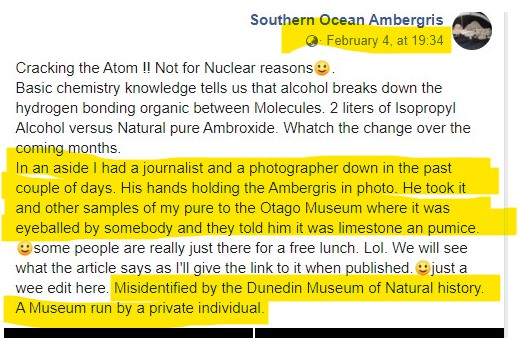
Of course the first question is how did Hamish McNeilly and Duncan Harold Payne connect? Did McNeilly approach Payne or the the other way round? It matters little because the timing reveals all.
On 3 Febuary Payne records on his facebook page a photo of limestone (alleged ambergris) taken by the Stuff photographer. Payne states, “His hands holding the ambergris…”.
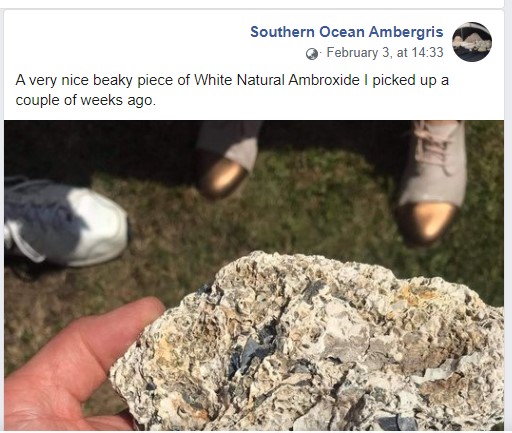
The piece and another was taken to the Otago Museum by McNeilly and on 4 February (1 day later) Payne records on his facebook page that the museum (Kane Fleury) confirms the pieces were not ambergris but were limestone and pumice. It should be noted that McNeilly’s article of the non-event on 1 February was published at 4.00pm (NZ time). The distance from Dunedin (McNeilly’s homebase) to Bluff is about 230 kms or about 3 hours drive.
Are we to believe that between 4 pm Monday 1st and 9 am Tuesday 2nd that Payne had managed to convince McNeilly sufficiently for him to commit time and resources to travel to Bluff and back on the basis that Payne had something worth reporting? Regardless of any alleged prior reporting of the non-event reported 1 February the timing and circumstances are beyond suspicious. Even if this fantastic scenario was possible McNeilly had an obligation to make some enquiries as to the veracity of Payne’s assertions. And of course the first and easiest venue is the Web. Three words into the google (or other) search engine; “duncan – payne – ambergris” is all it takes. The search results are invariable. Top of the list is AmbergrisBeware’s homepage and second is AmbergrisBeware’s page on scammer Duncan Harold Payne. Hamish McNeilly would have read AmbergrisBeware not only because of a web search but because AmbergrisBeware appears on Payne’s facebook page. McNeilly has confirmed he read Payne’s fakebook page. McNeilly has also acquired knowledge of the Singapore fiasco which he undoubtedly got from AmbergrisBeware.
While suspicious timing suggests a prior collusion between Hamish McNeilly and Duncan Harold Payne, what happened on 9 February clinches it. McNeilly had read AmbergrisBeware including the page on Duncan Harold Payne. He had acknowledged the accusation in Singapore of Payne selling pumice and limestone as ambergris. McNeilly has acknowledged the negative posts in Payne’s facebook page accusing him of selling rocks. McNeilly has reported ambergris as being ” wax-like” in his 1 February article and had physically felt Payne’s limestone which is not waxy. Further, on 4 February McNeilly was informed by the curator of Otago Museum that the samples provided by Payne were not ambergris but were limestone and pumice. Yet remarkably, 4 days later on 9 February McNeilly saw it appropriate that he not only publish an article and video on the Stuff website but also front page spread in the Southland Times (a local shelf-liner). And more remarkably McNeilly attempts to give Payne credence by making assertions such as: “Payne knows it well, from spending time at the home of a family’s friend on Stewart Island” (sic).
Hamish McNeilly asks the fatuous question; “Is this large collection ambergris?”, when he knows unequivocally that it is not. There is no doubt that Stuff and Duncan Harold Payne are colluding in this scam.
So why is Stuff going to such an extent to make a fool of itself? The answer is desperation and advertising revenue. It is not any anticipated revenue from the articles it’s published that are the motivation. It is the anticipated adverting revenue from the sponsor’s of these scams. They are the same sponsors that are and have been funding Duncan Harold Payne in his ongoing scamming and the sponsors are now funding a desperate media organization in NZ – Stuff. The sponsors are the IFRA or International Fragrance Association.
The IFRA represent big business. The IFRA represent Givaudan, Firminich and IFF, among others. Givaudan etc. represent the large perfume manufacturers such as Chanel, L’Oreal etc. Chanel alone generates an annual revenue of over 10 billion Euro making it nearly as large as Givaudan, Firminich and IFF combined. They are big advertisers that spend millions on marketing. Chanel etc. no longer rely on natural organic ingredients but now almost invariably use synthetic ingredients manufactured and supplied by Givaudan etc. Naturally occurring ingredients such as ambergris are now a threat to the synthetic ingredients made in laboratories by Givaudan etc. The big businesses know that people who have sufficient income will buy and consume organic food and produce that has not been subjected to chemical sprays or treatment such as pesticides and herbicides. Likewise those people will seek perfumes and fragrances that contain only organic ingredients and not artificially created ingredients in laboratories. Ambergris is very much a threat to Givaudan etc as all perfume must have a fixative, the present choice being natural organic ambergris or laboratory ambroxan.
The purpose of the media articles sponsored by the IFRA is to create an illusion of chaos and fraud in the ambergris industry. It is acknowledged that some mid-size and smaller fragrance manufacturers are bullied by the big supply businesses to deter the use of ambergris and instead buy ambroxan. The IFRA knows it has the support of the large manufacturers and their retailers. If the IFRA can eliminate ambergris from the market then it will control the sole source of the essential fixative component in fragrance. The IFRA is a corrupt organization obsessed with greed.
Are you getting your 61 cents worth of Stuff?
Stuff used be called Fairfax NZ Ltd. Due to abysmal reporting and poor management it was a failure so Fairfax sold it to Nine Entertainment (by way of merger) who then changed its name to Stuff. It was hoped that the name change would conceal its poor reputation but that also failed.
In May 2020 Nine Entertainment performed what could be described as a relatively successful redundancy deal. It had the option of liquidating the failed business and then spend the proceeds on redundancy payments to its executives. Instead it accepted NZ$1 from the CEO. That’s the equivalent of US0.61 cents. That’s the worth of Stuff. Stuff all.


Stuff is desperate. Very desperate. They have taken to online begging, asking for a dollar here or there – “change please mister”. So it is little wonder that it has engaged this pathetic attempt at deceiving the public. The CEO has been with this failed business for well over a decade so its apparent why it’s such a failure. The CEO is a desperate woman. She is stuff.
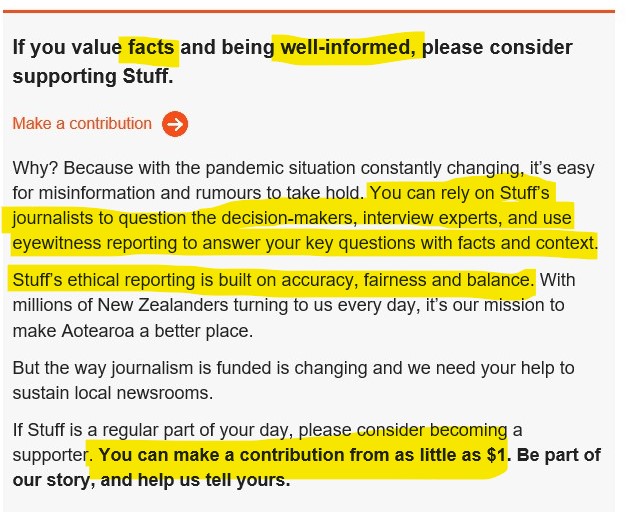
Stuff has attempted to engage other media organizations throughout the world in this deception. Most, if not all established media organizations that wish to retain at least the illusion of objectivity have not engaged. This is not surprising. They have read AmbergrisBeware and anticipated the consequences should they engage. That leaves only the fringe and obscure tabloid media to parrot the garbage generated by Stuff. As would be predicted this parroting has gone amok, one news site in Russia is calling ambergris “frozen whale vomit”. Hard to see how it deals with ambergris found in the Bahamas and with Payne holding a lighter to the alleged “frozen whale vomit” for quite sometime. It would have to be acknowledged that Stuff and these other fools represent the institutions that claim to bring you “facts” about a covid pandemic.
Stuff did however managed to engage the NZ television broadcaster TVNZ (17 February). However they had the wisdom not to refer to Duncan Harold Payne or Hamish McNeilly’s Stuff. They too had read AmbergrisBeware.
Kane Fleury and his Otago Museum have enjoyed a brief moment of exposure. Although it’s not the best of exposure. Fleury’s engagement with McNeilly is suspicious and his ambergris collection could only be described as pathetic. People are unlikely to visit his museum the view that pathetic display.
Hamish McNeilly’s Twitter page shows only 3 posts in relation to his garbage. Of course as moderator of his own page he gets to select those that appear positive – only 3. What he hasn’t published is the barrage of negative comments criticizing his decision to run such rubbish with the title question; “Is this large collection ambergris ?”, when it is plainly obvious beyond any doubt that it is not.
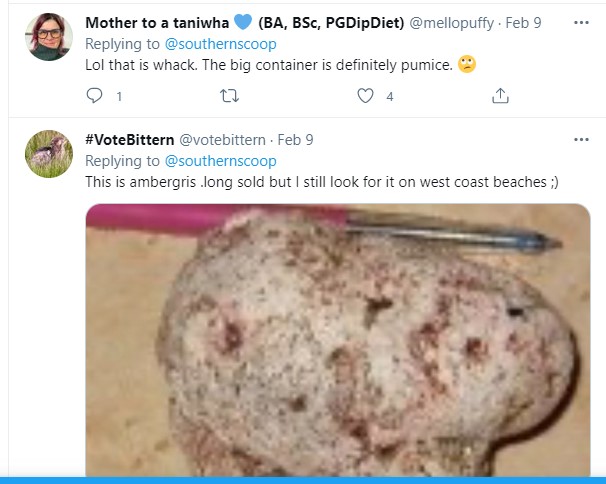
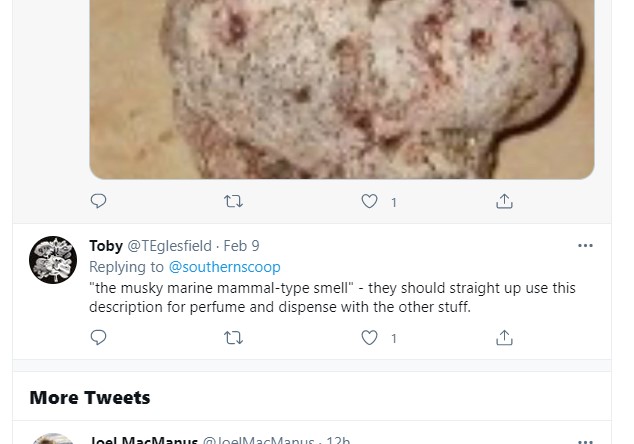
Hamish McNeilly has made a fool of himself.